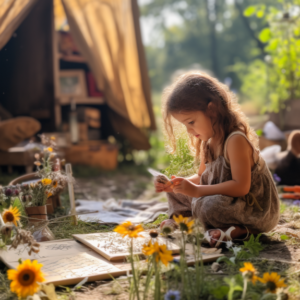As virtual preschool becomes a prevalent mode of early childhood education, fostering social interaction is crucial for the holistic development of young learners. Social interactions play a pivotal role in developing communication skills, emotional intelligence, and a sense of community. This article explores effective strategies for educators, parents, and caregivers to enhance social connections in the virtual preschool environment.
1. Virtual Circle Time:
- Interactive Greetings: Initiate virtual circle time with interactive greetings. This provides an opportunity for preschoolers to see and greet each other, fostering a sense of connection from the start.
- Share and Tell: Incorporate virtual show-and-tell sessions during circle time. This activity encourages preschoolers to share personal experiences, fostering communication and building a supportive virtual community.
2. Small Group Activities:
- Breakout Sessions: Implement breakout sessions for small group activities. This allows preschoolers to engage more actively with peers in a smaller setting, promoting collaboration and interaction.
- Collaborative Projects: Assign collaborative projects that require teamwork. Virtual group projects encourage communication, problem-solving, and the development of social skills.
3. Interactive Storytelling:
- Shared Storytelling: Conduct interactive storytelling sessions. Engage preschoolers by involving them in the creation of stories, encouraging verbal expression, and enhancing their narrative and language development.
- Puppet Shows: Use virtual puppet shows to make storytelling more interactive and entertaining. Preschoolers can create their own puppets and take turns presenting short stories.
4. Virtual Playdates:
- Scheduled Playdates: Organize scheduled virtual playdates for preschoolers. This provides an informal setting for social interaction, allowing children to engage in play and connect with their peers.
- Themed Playdates: Introduce themed playdates with specific activities or games. Themes can range from favorite characters to nature exploration, enhancing the play experience and creating shared memories.
5. Creative Expression:
- Art and Craft Sessions: Integrate virtual art and craft sessions. Encourage preschoolers to create artwork together, fostering creativity and providing a platform for self-expression and shared experiences.
- Music and Dance: Incorporate virtual music and dance sessions. Engaging in rhythmic activities promotes a sense of togetherness and allows preschoolers to express themselves through movement.
6. Virtual Field Trips:
- Interactive Exploration: Plan virtual field trips to explore different topics. This interactive approach allows preschoolers to learn together, ask questions, and share their observations, creating a sense of shared exploration.
- Post-Trip Discussions: After a virtual field trip, facilitate discussions to encourage preschoolers to share their thoughts and experiences. This promotes communication and strengthens the virtual bond among the group.
7. Emotional Check-Ins:
- Feelings and Emotions Sessions: Incorporate emotional check-ins during virtual sessions. Provide a platform for preschoolers to express their feelings, promoting emotional intelligence and empathy within the virtual community.
- Virtual Hugs and High Fives: Use virtual gestures like virtual hugs or high fives to create a sense of connection. These simple actions can help preschoolers feel acknowledged and supported.
8. Themed Dress-Up Days:
- Virtual Costume Days: Introduce virtual dress-up days with specific themes. Preschoolers can dress up according to the theme, creating a fun and engaging way to connect and share their creativity.
- Show and Share Outfits: Allow preschoolers to showcase their outfits during virtual sessions. This promotes self-expression and provides an opportunity for children to share a bit of their personality.
9. Parental Involvement:
- Family Engagement Activities: Encourage parental involvement in virtual activities. Plan family-oriented virtual events or activities that involve both preschoolers and their parents, fostering a sense of community beyond the classroom.
- Parent-Child Collaborations: Create opportunities for parents and preschoolers to collaborate on projects or activities. This strengthens the connection between home and virtual preschool, promoting a unified learning experience.
10. Celebrating Milestones:
- Virtual Celebrations: Organize virtual celebrations for birthdays, achievements, or milestones. This creates a sense of shared joy and allows preschoolers to celebrate each other’s successes.
- Recognition and Praise: Acknowledge and praise individual achievements during virtual sessions. Celebrating each child’s accomplishments contributes to a positive and supportive virtual community.
Conclusion:
Fostering social interaction in virtual preschool requires intentional planning and creative approaches. By incorporating strategies such as virtual circle time, small group activities, interactive storytelling, and themed playdates, educators, parents, and caregivers can create a vibrant and connected virtual learning environment. These strategies not only promote social skills but also contribute to the overall well-being and sense of community among preschoolers, laying a foundation for positive social development in their early years.



